
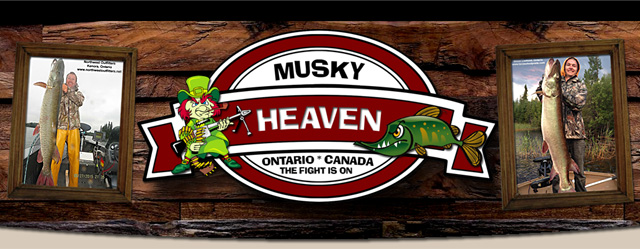

Southern watersheds flood several times a year, eroding banks and low lying fields. The oak, hickory, and poplar forests growing on the hillsides and banks have precious little soil to cling to, spreading huge root systems over the rock substrate under the shallow loam soil. Erosion and high winds drop trees all along the banks of lakes and streams creating ever-changing underwater forests. Muskies love wood cover. Whether weeds are present or not, wood attracts muskies. Weeds in flood control reservoirs are at the mercy of fluctuating water levels and clarity, and are often killed back by a late spring and cold muddy water. Wood, however, is always present, and muskies use it periodically throughout the year, especially as southern waters cool in the fall. On Kentucky's Green River Lake near the Tennessee border, crankbaiting submerged logs and brush piles is a deadly fall pattern.
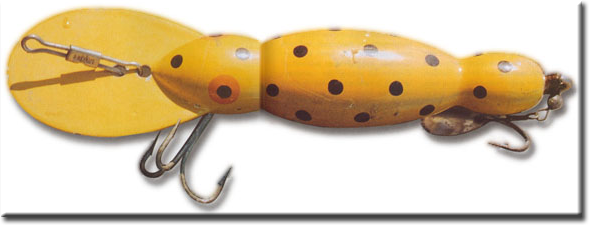 During warmer, clear water periods, filamentous green algae grows in long, flowing strands from shallow wood and rocks. Algaes are abundant in both the filamentous forms that look like green hair on a rock or stick, and free-floating single and multicellular forms. Algaes, lacking the cellular integrity and organelles typical of higher plants, are classified as "protista." They contain two types of chlorophyll and manufacture their own nutrition, releasing oxygen in the process, like higher plants. Moderate algae growth in warm water increases dissolved oxygen levels. While heavy growth can decay and produce toxins in smaller ponds and lakes, growth in open lake environments with low to moderate fertility and current rarely reach toxic levels.
During warmer, clear water periods, filamentous green algae grows in long, flowing strands from shallow wood and rocks. Algaes are abundant in both the filamentous forms that look like green hair on a rock or stick, and free-floating single and multicellular forms. Algaes, lacking the cellular integrity and organelles typical of higher plants, are classified as "protista." They contain two types of chlorophyll and manufacture their own nutrition, releasing oxygen in the process, like higher plants. Moderate algae growth in warm water increases dissolved oxygen levels. While heavy growth can decay and produce toxins in smaller ponds and lakes, growth in open lake environments with low to moderate fertility and current rarely reach toxic levels.
lgaes fuel southern ecosystems. Filamentous and suspended algaes are the primary food source for shad, the predominant baitfish in southern reservoirs. Along the sides of boat docks, algae can be seen growing from shallow underwater surfaces. Gizzard shad glide along the boards picking bits and pieces of algae as they go. They nose into the algae, tearing off bites in a series of rapid jerks. They feed on algae growing on submerged wood and rock as well, and muskies hunt the cover ambushing the shad as they graze.
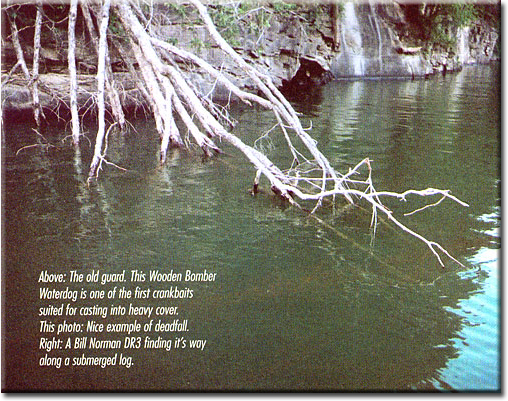 Juvenile shad roam open water in schools, easily visible on still days at dawn and dusk as ripples on the surface feeding on suspended organisms, primarily algae. As they grow they become more and more dependant on fixed filamentous algae growing on logs, sticks and rocks, and less dependant on smaller suspended single and multicellular algae forms. A 3-year old gizzard shad can be 5 to 7 inches in length, and can reach 12 inches or more by age 5. These big shad are too big for walleyes and bass to forage on effectively, and become the primary forage fish for apex predators including stripers and muskies.
Juvenile shad roam open water in schools, easily visible on still days at dawn and dusk as ripples on the surface feeding on suspended organisms, primarily algae. As they grow they become more and more dependant on fixed filamentous algae growing on logs, sticks and rocks, and less dependant on smaller suspended single and multicellular algae forms. A 3-year old gizzard shad can be 5 to 7 inches in length, and can reach 12 inches or more by age 5. These big shad are too big for walleyes and bass to forage on effectively, and become the primary forage fish for apex predators including stripers and muskies.
Wood cover attracts shad and other baitfish, both as cover and adds an endless source of algae growth. Muskies targeting feeding shad in the trees are suckers for lures that effectively mimic the baitfish as they graze algae from the limbs. Consumed with feeding, shad often become careless, making them easy targets for predators hunting in the cover. On southern reservoirs like Green River and Buckhorn Lakes, algae growth on submerged wood continues well into fall. Big muskies will move into wood cover and feed heavily as winter approaches.
Wood cover attracts shad and other baitfish, both as cover and adds an endless source of algae growth. Muskies targeting feeding shad in the trees are suckers for lures that effectively mimic the baitfish as they graze algae from the limbs. Consumed with feeding, shad often become careless, making them easy targets for predators hunting in the cover.
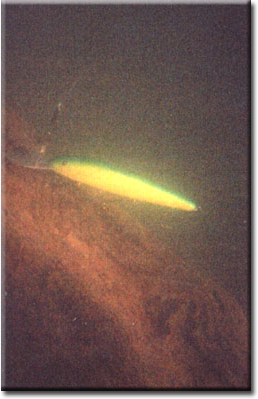 Most anglers reach for a spinnerbait first to fish heavy cover. They offer limitless blade combinations and colors, and long-arm, single hook models work well in cover on a steady retrieve. They have their drawbacks, however. A favorite of bass anglers, spinnerbaits may be the most common lure muskies see. By the time autumn rolls around, muskies have seen and felt the vibration of a blade a thousand times over. Spinnerbaits can be bounced around somewhat in thin cover, but in thick branches they snag easily. Additionally, experienced musky anglers usually agree that the one lure they have lost more big fish on than any other would probably be a single hook spinnerbait.
Most anglers reach for a spinnerbait first to fish heavy cover. They offer limitless blade combinations and colors, and long-arm, single hook models work well in cover on a steady retrieve. They have their drawbacks, however. A favorite of bass anglers, spinnerbaits may be the most common lure muskies see. By the time autumn rolls around, muskies have seen and felt the vibration of a blade a thousand times over. Spinnerbaits can be bounced around somewhat in thin cover, but in thick branches they snag easily. Additionally, experienced musky anglers usually agree that the one lure they have lost more big fish on than any other would probably be a single hook spinnerbait.
Crankbaits can be an effective option for fishing cover, especially as the year wears on. In late spring, usually late May or early June in Kentucky, big gizzard shad begin feeding on the algae growth on the submerged wood continuing well into fall. Post-spawn carp leave mudflats and often suspend in or over deep wood cover, especially deadfalls over the channels.
Muskies quickly follow, staying until the baitfish leave or temperatures heat up in mid-summer. When fall rolls around, baitfish and muskies again move into the trees. Anglers recognizing the time-temperature-baitfish relationships involved quickly find ways to draw strikes from fish hunting the edges of the cover or buried in the middle of it. Negative and neutral fish simply will not move to the edge of the cover to take a lure. Active fish usually will be on the edge or close to it, depending on where the shad are feeding.
While color certainly plays a role in feeding behavior of muskies, evidence seems to indicate that sound may be the most critical factor. The difference in sound transmission in water compared to air is enormous.
These lures have the big lips that dig into and deflect off objects, preventing the hooks from hanging up. The water the lip pushes provides lift as the bait closes on an object, helping deflect the bait and producing sound as well. These lures, once mastered, can be cranked through really thick stuff.
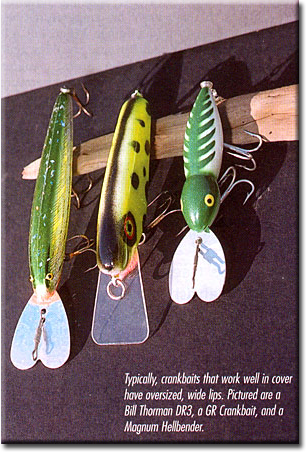 Solid wooden lures without rattles produce significant sound underwater, while hollow plastic baits with rattles are unbelievably loud. Depending on the mood of the fish, one or the other may be much more effective at any given time.
Solid wooden lures without rattles produce significant sound underwater, while hollow plastic baits with rattles are unbelievably loud. Depending on the mood of the fish, one or the other may be much more effective at any given time.
Louder is not always better. Everything that moves underwater produces sound, often subtle, but detectable by the lateral line system of a musky. A crankbait has its own inherent sound capabilities in open water, but start banging it into wood or rock cover and it explodes with noise. Rattles strike me as unnatural, even obnoxious, underwater. At times, however, muskies (and other gamefish) love them. You can order some very popular baits, including Believers among others, without rattles by special order. Even in muddy water with near zero visibility, I have had more success with baits without rattles, especially casting. Speed trolling is another matter entirely. Lil' Ernies, Stalkers, and Believers with rattles excel here, possibly because of motor noise. More on that another time.
Crankbaits are designed with a particular purpose in mind. Baits designed for cranking cover usually have a big heart-shaped, round, or square lip, are very buoyant, have relatively small hooks, and have a tail-up posture in the water. Hellbenders, Bill Norman DR3s, Party Crashers, and Shad Baits by G. Richardson all have these characteristics. The Shad Bait has no rattles, but the hooks, split rings, and the flat sides all produce sound.
These lures have the big lips that dig into and deflect off objects, preventing the hooks from hanging up. The water the lip pushes provides lift as the bait closes on an object, helping deflect the bait and producing sound as well. These lures, once mastered, can be cranked through really thick stuff. These big-lipped baits are not good with speed, becoming unstable and blowing out as speed increases. They are designed for slow, bottom bouncing, wood banging retrieves.
Consistency with equipment and lures is key to developing the finesse necessary to fish these lures in thick brush and logs. Same rod, line, terminal tackle every time for each type crankbait. One even tends to develop a feel for individual crankbaits, especially wooden models. I have one particular Shad Bait that has a slightly different action, a tighter wobble, than any of the others. I have caught several fish on that bait, and I tend to go to it time and time again.
Rods for fishing these crankbaits in wood need to be medium-heavy action and probably 7-1/2 feet in length. Longer rods allow better control of the lure, quick changes in retrieve angle, and help in controlling hooked fish. Short, stiff rods make poor crankbait rods. Rods of quality graphite with excellent sensitivity are necessary because you are totally dependent on feel to control the lure. There are several excellent rods available for crankbaits, including the St. Croix Avid and Premier series (MH76P) and ESOX Rods 7-1/2 models, which I absolutely love because of their low weight and super sensitivity. A bigger bait with a lot of pull needs a little heavier rod, while smaller baits like magnum Hellbenders and Norman DR3s do well on a lighter model. Sharp hooks and braided line make hookups much easier and allow the use of softer rods. Longer, softer rods maintain line tension much better and cut down on lost fish.
Braided lines like Power Pro, Cortland Braid, and TUF Line are all excellent lines and a must for this kind of fishing. I use 65-pound Power Pro, have for years, and have never had a single line failure. Lure control requires superb feel. Braided line transmits every bump and grind of the lure to the rod tip.
Line may be the most critical component of all. Monofilament lines are at a decided disadvantage in heavy cover. They are slicker than braid and slide over wood more smoothly, but have few other positive attributes. Line failure from repeated abrasion is common. Braided lines like Power Pro, Cortland Braid, and TUF Line are all excellent lines and a must for this kind of fishing. I use 65-pound Power Pro, have for years, and have never had a single line failure. Lure control requires superb feel. Braided line transmits every bump and grind of the lure to the rod tip. The more information the better. Consistently interpreting this information allows an experienced angler to utilize the versatility of a crankbait in places muskies rarely encounter them. Know your limitations and those of your equipment. Experience will dictate how aggressively you can comfortably crank the thick stuff.
Terminal tackle also plays a major role. Leaders should be strong with adequate snaps. Big swivels or split rings at the line attachment should be avoided. They hang on everything, tending to fall quickly on slack line and change lure action. On some crankbaits, I even avoid a snap at the eye, opting instead for a split ring to save weight and bulk. Over the years, I have developed confidence in a few crankbaits and change rarely during the day, so split rings work well for me.
Interpreting baitfish locations, water conditions, and weather patterns are among factors determining musky location at any particular time. And fall can be prime time to find big muskies in heavy wood cover. But crankbaits cannot catch muskies from cover if they aren't there. Notorious migrators in flood control reservoirs, muskies move frequently for reasons that are often less than obvious. Compared to walleyes or bass, they can be difficult to pattern, due to their unpredictability and low population density. High pressure systems usually push fish tight to cover, but may cause them to suspend off the cover in open water. Bright sunlight in clear water also tends to pack them tight into the cover. Switching to a UP Ernie or Triple D and fan casting the adjacent area may be necessary when nothing is happening in the wood. Anglers tend to pound visible deadfalls and brush piles wondering why they can't raise a fish long after the fish have moved on. Keep an open mind and adapt. In late spring and again in fall when a significant number of muskies are in this pattern, however, crankbaits are an excellent option.
Dr. Gene Smith